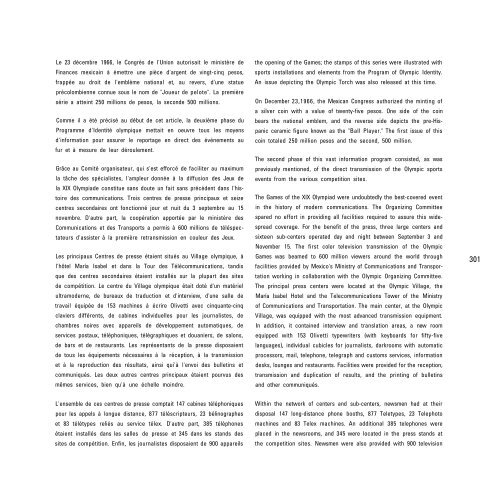Mexico City Olympic Games Official Report ... - LA84 Foundation
Mexico City Olympic Games Official Report ... - LA84 Foundation
Mexico City Olympic Games Official Report ... - LA84 Foundation
Create successful ePaper yourself
Turn your PDF publications into a flip-book with our unique Google optimized e-Paper software.
Le 23 décembre 1966, le Congrès de l'Union autorisait le ministère de<br />
Finances mexicain à émettre une pièce d'argent de vingt-cinq pesos,<br />
frappée au droit de l'emblème national et, au revers, d'une statue<br />
précolombienne connue sous le nom de "Joueur de pelote". La première<br />
série a atteint 250 millions de pesos, la seconde 500 millions.<br />
Comme il a été précisé au début de cet article, la deuxième phase du<br />
Programme d'Identité olympique mettait en oeuvre tous les moyens<br />
d'information pour assurer le reportage en direct des événements au<br />
fur et à mesure de leur déroulement.<br />
Grâce au Comité organisateur, qui s'est efforcé de faciliter au maximum<br />
la tâche des spécialistes, l'ampleur donnée à la diffusion des Jeux de<br />
la XIX Olympiade constitue sans doute un fait sans précédent dans l'his-<br />
toire des communications. Trois centres de presse principaux et seize<br />
centres secondaires ont fonctionné jour et nuit du 3 septembre au 15<br />
novembre. D'autre part, la coopération apportée par le ministère des<br />
Communications et des Transports a permis à 600 millions de téléspec-<br />
tateurs d'assister à la première retransmission en couleur des Jeux.<br />
Les principaux Centres de presse étaient situés au Village olympique, à<br />
l'hôtel María Isabel et dans la Tour des Télécommunications, tandis<br />
que des centres secondaires étaient installés sur la plupart des sites<br />
de compétition. Le centre du Village olympique était doté d'un matériel<br />
ultramoderne, de bureaux de traduction et d'interview, d'une salle de<br />
travail équipée de 153 machines à écrire Olivetti avec cinquante-cinq<br />
claviers différents, de cabines individuelles pour les journalistes, de<br />
chambres noires avec appareils de développement automatiques, de<br />
services postaux, téléphoniques, télégraphiques et douaniers, de salons,<br />
de bars et de restaurants. Les représentants de la presse disposaient<br />
de tous les équipements nécessaires à la réception, à la transmission<br />
et à la reproduction des résultats, ainsi qui'à l'envoi des bulletins et<br />
communiqués. Les deux autres centres principaux étaient pourvus des<br />
mêmes services, bien qu'à une échelle moindre.<br />
L'ensemble de ces centres de presse comptait 147 cabines téléphoniques<br />
pour les appels à longue distance, 877 téléscripteurs, 23 bélinographes<br />
et 83 télétypes reliés au service télex. D'autre part, 385 téléphones<br />
étaient installés dans les salles de presse et 345 dans les stands des<br />
sites de compétition. Enfin, les journalistes disposaient de 900 appareils<br />
the opening of the <strong>Games</strong>; the stamps of this series were illustrated with<br />
sports installations and elements from the Program of <strong>Olympic</strong> Identity.<br />
An issue depicting the <strong>Olympic</strong> Torch was also released at this time.<br />
On December 23,1966, the Mexican Congress authorized the minting of<br />
a silver coin with a value of twenty-five pesos. One side of the coin<br />
bears the national emblem, and the reverse side depicts the pre-His-<br />
panic ceramic figure known as the "Ball Player." The first issue of this<br />
coin totaled 250 million pesos and the second, 500 million.<br />
The second phase of this vast information program consisted, as was<br />
previously mentioned, of the direct transmission of the <strong>Olympic</strong> sports<br />
events from the various competition sites.<br />
The <strong>Games</strong> of the XIX Olympiad were undoubtedly the best-covered event<br />
in the history of modern communications. The Organizing Committee<br />
spared no effort in providing all facilities required to assure this wide-<br />
spread coverage. For the benefit of the press, three large centers and<br />
sixteen sub-centers operated day and night between September 3 and<br />
November 15. The first color television transmission of the <strong>Olympic</strong><br />
<strong>Games</strong> was beamed to 600 million viewers around the world through<br />
facilities provided by <strong>Mexico</strong>'s Ministry of Communications and Transpor-<br />
tation working in collaboration with the <strong>Olympic</strong> Organizing Committee.<br />
The principal press centers were located at the <strong>Olympic</strong> Village, the<br />
María Isabel Hotel and the Telecommunications Tower of the Ministry<br />
of Communications and Transportation. The main center, at the <strong>Olympic</strong><br />
Village, was equipped with the most advanced transmission equipment.<br />
In addition, it contained interview and translation areas, a new room<br />
equipped with 153 Olivetti typewriters (with keyboards for fifty-five<br />
languages), individual cubicles for journalists, darkrooms with automatic<br />
processors, mail, telephone, telegraph and customs services, information<br />
desks, lounges and restaurants. Facilities were provided for the reception,<br />
transmission and duplication of results, and the printing of bulletins<br />
and other communiqués.<br />
Within the network of centers and sub-centers, newsmen had at their<br />
disposal 147 long-distance phone booths, 877 Teletypes, 23 Telephoto<br />
machines and 83 Telex machines. An additional 385 telephones were<br />
placed in the newsrooms, and 345 were located in the press stands at<br />
the competition sites. Newsmen were also provided with 900 television<br />
301
















